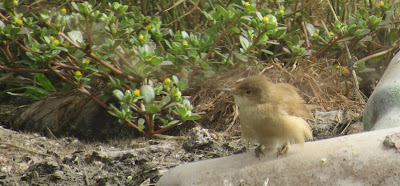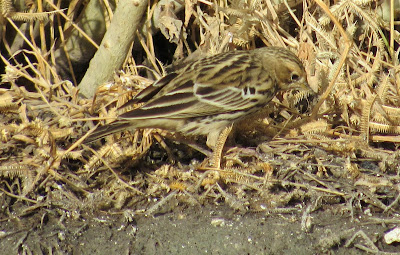Saturday was no exception. Once again it provided an addition to my Mauritanian list too.
This time it was a mallard.
mallard swimming
Mallard is extremely uncommon south of the Sahara in West Africa. Records in Mauritania have been restricted to autumn in Nouadhibou and Banc d'Arguin and winter in the Senegal River delta. It is a vagrant elsewhere in West Africa.
mallard resting
It was not the only duck at the main water area. There were three northern pintail and about 15 common teal.
The mallard, however, was not mixing with them. It was actually less timid and stayed long after the other ducks had taken to the air.
northern pintail
For the first couple of hours at the site, the weather was very dusty and visibility was very poor. However I could see, through the haze, that one of the northern pintail was more reluctant to fly than the others. I wonder if it was ill or just had a different temperament.
Before concentrating on the ducks, I spent time observing the waders.
kentish plover
Kentish plover was the most numerous wader for the first time since parts of last winter.
thin dunlin
One dunlin caused me identification headaches. It was thinner than usual and made me consider curlew sandpiper. However it didn't have long legs and the supercilium was weak. Furthermore it's bill wasn't exceptionally long.
ruff
Ruff were present once again.
litte ringed plover
ringed plover
I don't recall seeing any gulls at the site before. A black-headed gull arrived and left within five minutes.
black-headed gull
red-throated pipit
I saw one red-throated pipit and two tree pipit which was exactly the same count as two weeks ago. i doubt they were the same birds though.
three blue-cheeked bee-eater
Another similarity with two weeks ago was a wave of blue-cheeked bee-eater coming through on passage. When they passed through, I was left with the same count of around six blue-cheeked bee-eater which have been local since the summer.
namaqua dove
No turtle dove seem to be left from the autumn migration. The only doves seen this time were laughing dove and Namaqua dove.
whinchat
The diversity of passerines was still high. A rather battered looking whinchat was found.
northern wheatear
Both black-eared wheatear and northern wheatear were on site. One beautiful male black-eared wheatear escaped my camera sadly.
The mix of warblers has been constantly changing all autumn. No garden warbler or willow warbler were seen this time.
It has reached the stage of the year where most warbler species now seen are those which can stay all winter.
There were many common chiffchaff. Some birds were almost certainly Iberian chiffchaff.
Concernig the latter species, it now appears that it does winter in south west Mauritania as confirmed in the Atlas of Mauritanian birds and contrary to other sources which say this happens only in northern Senegal and Northern Mali.
Iberian chiffchaff 1
The bird in this two pictures is believed to be an Iberian chiffchaff as identified by two Spain based birders.
The leg colour is intermediate between a typical common chiffchaff and typical willow warbler as is the primary projection. Plumage colours and facial pattern are good for Iberian chiffchaff too.
Iberian chiffchaff
blackcap 1
blackcap2
While looking at the warblers in one spot with low bushes near mud and shallow water, a very young Fulvous babbler appeared briefly. I have little doubt that the species breeds at the site and probably inside the thick bushes at that spot.
young Fulvous babbler 1
This bird looked like a fledgling.
young fulvous babbler 2
As always I went back towards the car under the canopy of the avenue of trees. Here I saw European pied flycatcher and several common redstart. There was also a sub-alpine warbler and one sardinian warbler.
European pied flycatcher inside the trees
Sadly the European scops owl I had been seeing was now just a pile of feathers. It had been attacked and eaten either by a cat or bird of prey. The attrition rate of this species in winter was known to be high when I birded in Oman. It looks like it might be here too.
I won't let this sad event detract from an otherwise good birding session.
Mallard
Northern Pintail
Eurasian Teal
Glossy Ibis
Common Buzzard
Stone-curlew
Spur-winged Lapwing
Kentish Plover
Common Ringed Plover
Little Ringed Plover
Whimbrel
Ruff
Dunlin
Little Stint
Common Snipe
Wood Sandpiper
Black-headed Gull
Laughing Dove
Namaqua Dove
Eurasian Hoopoe
Blue-cheeked Bee-eater
Eurasian Wryneck
Common Kestrel
Southern Grey Shrike
Crested Lark
Barn Swallow
Common House Martin
Common Chiffchaff
Iberian Chiffchaff
Iberian Chiffchaff
Eurasian Reed Warbler
Eurasian Blackcap
Subalpine Warbler
Sardinian Warbler
Fulvous Babbler
Bluethroat (White-spotted)
European Pied Flycatcher
Common Redstart
Northern Wheatear
Black-eared Wheatear
White Wagtail
Tree Pipit
Red-throated Pipit
House Sparrow




















































